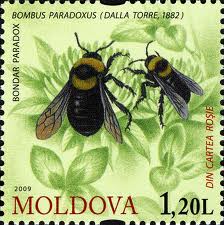Bees in agricultural landscapes are exposed to dietary pesticides such as imidacloprid when they feed from treated mass-flowering crops. Concern about the consequent impact on bees makes it important to understand their resilience. In the laboratory, we therefore fed adult worker bees on dosed syrup (125 µg L-1 imidacloprid, 98 µg kg-1) either continuously or as a pulsed exposure and measured their behaviour (feeding and locomotory activity) and whole-body residues. On dosed syrup, honey bees maintained much lower bodily levels of imidacloprid than bumble bees (< 0.2 ng vs. 2.4 ng imidacloprid per bee). Dietary imidacloprid did not affect the behaviour of honey bees but it reduced feeding and locomotory activity in bumble bees. After the pulsed exposure, bumble bees cleared bodily imidacloprid after 48 hours and recovered behaviourally. We attribute the differential behavioural resilience of the two species to the observed differential in bodily residues. The ability of bumble bees to recover may be environmentally relevant in wild populations that face transitory exposures from the pulsed blooming of mass-flowering crops.
Source:
James E. Cresswell, François-Xavier L. Robert, Hannah Florance and Nicholas
Smirnoff (2013). Pest Management Science:
http://dx.doi.org/10.1002/ps.3569
http://onlinelibrary.wiley.com/doi/10.1002/ps.3569/abstract

- Login om te reageren

An attempt to discredit irreversible receptor binding by neonics
The authors assert that the reversibility of the interactions of imidacloprid with their target sites in the insect nervous system is contested and that if an assimilated pesticide binds persistently to its target receptors, symptoms should persist after dietary exposure ceases. They argue that behavioural recovery of bumblebees fed undosed syrup undermines previous assertions that imidacloprid irreversibly blocks nicotinic acetylcholine receptors (nAChRs) in the central nervous system of insects. However, attempting to clarify the reversibility of receptor binding with observed symptoms is dodgy to say the least. A single prenatal dose of the alkylating agent ethylnitrosourea (ENU), which has a half-life of 5 minutes in vivo, will cause irreversible (covalent) binding to DNA which eventually results in nervous system cancer, but the offspring will develop completely normally showing no signs whatsoever while their fate has been sealed by the initiation of a carcinogenic process. Similarly, imidacloprid-treated honeybees displayed no signs that could be related to receptor binding. The real question therefore is what kind of process was set in motion by receptor interactions. The paper does not present mortality data, so I presume, mortality of groups of bees was not monitored. But I would not be surprised if those bees that had been exposed to imidacloprid had a much shorter life expectancy. And if that would be the case, there must have been an ongoing process inflicted by the neonicotinoid interacting with receptors that caused these early deaths. So, as I see it, the authors failed to ascertain whether or not the dosing protocol resulted in excess mortality, relative to non-treated controls. Secondly, the authors cite a letter to the Editor of the journal Toxicology by Bayer scientists Maus and Nauen (reference 27), but not the rebuttal by Tennekes (attached), who argues that even if he adopts the reasoning of Maus and Nauen, which is in stark contrast with that of Bayer scientist Abbink at the time when imidacloprid was introduced, his reasoning is that, in practical terms, receptor binding is virtually irreversible, because the time constant for dissociation is bound to be very high (acetylcholinesterase is unable to remove the neonicotinoid from the binding site). Other Bayer scientists (Mehlhorn et al, Parasitol Res (1999) 85: 625-637) have also asserted that "the irreversible blocking of the nACh receptors leads to a lethal hyperactivity of the nerves and muscles of the insect." So, dissociation, if it occurs at all, is a very slow process and this explains time-dependent toxicity, as expressed in the Druckrey-Küpfmüller equation. Thirdly, Tennekes and Sanchez-Bayo have recently validated the Druckrey-Küpfmüller theorem with the molecular mechanisms of action of a great number of compounds that followed either the Druckrey-Küpfmüller equation or Haber’s rule in various test models (attached). Fourthly, I did not see any declaration of competing interests while reliable sources assert that James Cresswell receives funds from Syngenta. Fifthly, it is now fairly clear that James Cresswell is trying to discredit all critical papers on neonics by independent scientists, and I presume that is not a coincidence if his financial resources are anything to judge by. Recently, the State of Nature report was launched in London, showing the miserable state of the British country side that I enjoyed so much when I was working in the UK in the 1970s. Cresswell will probably argue that this has nothing to do with environmental pollution with neonics. But I can assure him that many reputable scientists would disagree with him there.